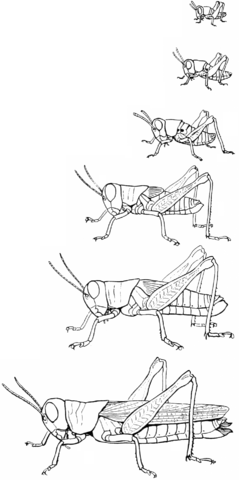Reproduction
The life cycle of a grasshopper must move quickly through a six-week
metamorphosis in order to ensure future generations of the species (Snodgrass,
1967). Like many insects grasshoppers engage in direct sexual
reproduction. During sexual reproduction the male deposits a
spermatophore or sperm packet into the females vagina. The sperm then
travels through tiny canals called micropyles before entering the eggs.
After fertilization the female uses a set of prongs on her posterior
region to deposit her eggs underground. The set of prongs called the
ovipositor act as a digging tool that allows the female to deposit her
eggs a few centimeters below ground
(Snodgrass, 1967).
The Fertilized eggs remain dormant for up to ten months before hatching
in early summer. The newly hatched offspring or nymphs are the first
part a six-stage complete hemimetabolous metamorphosis. The term
hemimetabolous refers to the fact that all stages of the metamorphosis
look like the adult stage or put simply, the babies look like smaller
versions of the adults.
If food is plentiful the young grasshopper will grow and move quickly
through the stages of its life. However, the growth of grasshopper poses
a curious dilemma. Like most other arthropods the body of the animal is
composed of a tough exoskeleton. In the case of the grasshopper this
exoskeleton is made primarily of chitin. This body plan differs from
most vertebrate animals in that the muscles are connected directly to
the hardened skin or cuticula of the organism. It is this armored shell
that poses a problem. The insect seems to either be trapped in its
nymphal state or doomed to death by compression within its’ own body.
Fortunately, grasshoppers and many other arthropods circumvent this
problem through a process called molting
(Snodgrass, 1967).
Molting is a process where the insect effectively sheds its outer layer
in exchange for a new bigger one. The molting processes are actually
what define each of the six stages of a grasshoppers’ life cycle. Each
molt marks the start of a new stage so, a grasshopper molts six times in
its life. So, how does a grasshopper grow in between molts if its
exoskeleton is so rigid? Although the chitinous skin is unyielding the
insect is not composed of one solid shell. Instead the body is made up
of multiple segments of hard tissue separated and connected by flexible
membranes. These membranes stretch and allow for a limited amount of
growth before the animal needs to molt and start the process over again
(Snodgrass, 1967).
Once the grasshopper reaches the final fully developed adult stage it is
sexually mature and ready to complete the cycle. By this time it is late
in the summer season and the grasshoppers have a very short period of
time to reproduce before fall weather destroys the generation. To combat
this potential problem and expedite the reproductive process male
grasshoppers have a special adaptation that allows them to call out to
females and attract potential mates. Through a process called
stridulation male grasshoppers can produce a sound by rubbing modified
parts of their fore wings together (Hugh, 1966). This sound, in addition
to crickets and katydids, is the part of the late summer night symphony
of chirping commonly heard throughout the United States. However, this
sound is not meant for people amusement. The specific noise made by male
M. differentialis is unique
to the species and individual and is meant as a mating call to females.
The females can detect the vibrations through a specialized ear called a
tympanum. If lucky, the chirping sound will attract a female and the
pair can mate and complete the grasshopper lifecycle.

